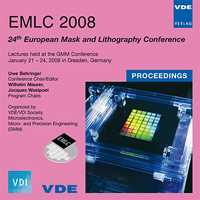Assessment of molecular contamination in mask pod
Konferenz: EMLC 2008 - 24th European Mask and Lithography Conference
21.01.2008 - 24.01.2008 in Dresden, Germany
Tagungsband: EMLC 2008
Seiten: 7Sprache: EnglischTyp: PDF
Persönliche VDE-Mitglieder erhalten auf diesen Artikel 10% Rabatt
Autoren:
Foray, Jean Marie; Davene, Magali; Favre, Arnaud; Rude, C.; Trautmann, T. (Alcatel Vacuum, 98 avenue Brogny, 74000 Annecy, France)
Dejaune, Patrice; Sergent, Pierre (Toppan Photomasks, avenue JF Kennedy, 91 100 Corbeil, France)
Gough, Stuart (STM, 38926 Crolles,Cedex, France)
Tissier, Michel (Toppan Photomasks, Avenue Victoire, 13106 Rousset, France)
Cheung, D. (Entegris Cleaning Process, 395 rue Louis Lepine, 34000 Montpellier, France)
Fontaine, H.; Veillerot, M. (CEA-LETI-MINATEC; 17 rue des martyrs, 38 054 Grenoble cedex 9, France)
Avary, K.; Hollein, I.; Lerit, R. (Advanced Mask Technology Center GmbH & Co. KG, Raehnitzer Allee 9, D-01109 Dresden, GERMANY)
Inhalt:
Context/study: Motivation Contamination and especially Airbone Molecular Contamination (AMC) is a critical issue for mask material flow with a severe and fairly unpredictable risk of induced contamination and damages especially for 193 nm lithography. It is therefore essential to measure, to understand and then try to reduce AMC in mask environment. Mask material flow was studied in a global approach by a pool of European partners, especially within the frame of European MEDEA+ project, so called “MUSCLE”. This paper deals with results and assessment of mask pod environment in term of molecular contamination in a first step, then in a second step preliminary studies to reduce mask pod influence and contamination due to material out gassing. Approach and techniques: A specific assessment of environmental / molecular contamination along the supply chain was performed by all partners. After previous work presented at EMLC 07[i], further studies were performed on real time contamination measurement pod at different sites locations (including Mask manufacturing site, blank manufacturing sites, IC fab). Studies were linked to the main critical issues: cleaning, storage, handling, materials and processes. Contamination measurement campaigns were carried out along the mask supply chain using specific Adixen analyzer in order to monitor in real time organic contaminants (ppb level) in mask pods. Key results would be presented: VOC, AMC and humidity level on different kinds of mask carriers, impact of basic cleaning on pod outgassing measurement (VOC, NH3), and process influence on pod contamination … In a second step, preliminary specific pod conditioning studies for better pod environment were performed based on Adixen vacuum process. Process influence had been experimentally measured in term of molecular outgassing from mask pods. Different AMC experimental characterization methods had been carried out leading to results on a wide range of organic and inorganic contaminants: by inline techniques based on Adixen humidity, also VOC and organic sensors, together by off-line techniques already used in the extensive previous mask pods benchmark (TD-GCMS & Ionic Chromatography). Humidity and VOC levels from mask carriers had shown significant reduction after Adixen pod conditioning process. Focus had been made on optimized vacuum step (for AMC) after particles carrier cleaning cycle. Based upon these key results new procedures, as well as guidelines for mask carrier cleaning optimization are proposed to improve pod contamination control. Summary results/next steps: This paper reports molecular contamination measurement campaigns performed by a pool of European partners along the mask supply chain. It allows us to investigate, identify and quantify critical molecular contamination in mask pod, as well as VOC and humidity, issues depending on locations, uses, and carrier’s type. Preliminary studies highlight initial process solutions for pods conditioning that are being used for short term industrialization and further industrialized.


